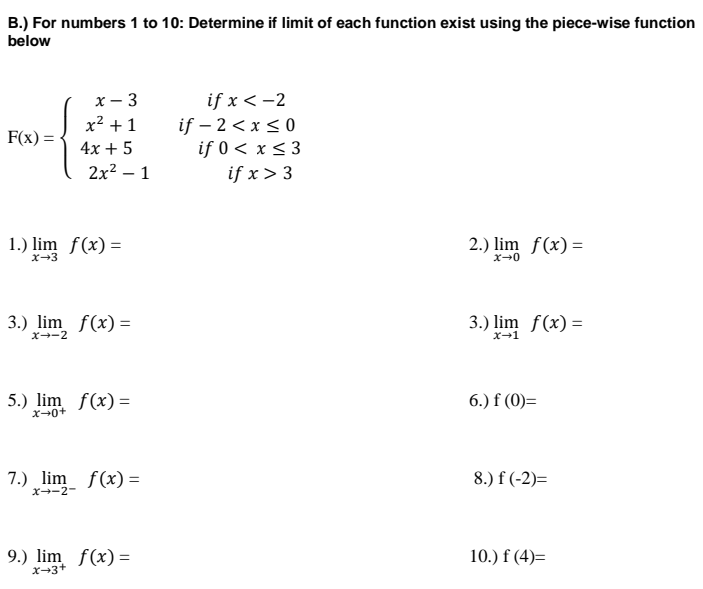B.) For numbers 1 to 10: Determine if limit of each function exist using the piece-wise function below x - 3 if x < -2 if -2 3 1.) lim f(x) = 2.) lim f(x) = X-3 x→0 3.) lim f(x) = 3.) lim f(x) = x--2 x-1 5.) lim f(x) = 6.) f (0)= x→0+ 7.) lim f(x) = 8.) f(-2)= x-2- 9.) lim f(x) = 10.) f (4)= X-3+ 4x + 5 2x² - 1
B.) For numbers 1 to 10: Determine if limit of each function exist using the piece-wise function below x - 3 if x < -2 if -2 3 1.) lim f(x) = 2.) lim f(x) = X-3 x→0 3.) lim f(x) = 3.) lim f(x) = x--2 x-1 5.) lim f(x) = 6.) f (0)= x→0+ 7.) lim f(x) = 8.) f(-2)= x-2- 9.) lim f(x) = 10.) f (4)= X-3+ 4x + 5 2x² - 1
Chapter3: Functions
Section3.3: Rates Of Change And Behavior Of Graphs
Problem 2SE: If a functionfis increasing on (a,b) and decreasing on (b,c) , then what can be said about the local...
Related questions
Question
Show step-by-step solution. Please answer numbers 5-10.

Transcribed Image Text:B.) For numbers 1 to 10: Determine if limit of each function exist using the piece-wise function
below
x - 3
if x < -2
if -2<x<0
x² + 1
F(x) =
if 0 < x≤ 3
if x > 3
1.) lim f(x) =
2.) lim f(x) =
X-3
x→0
3.) lim f(x) =
3.) lim f(x) =
x--2
x-1
5.) lim f(x) =
6.) f (0)=
x→0+
7.) lim f(x) =
8.) f(-2)=
x-2-
9.) lim f(x) =
10.) f (4)=
X-3+
4x + 5
2x² - 1
Expert Solution
This question has been solved!
Explore an expertly crafted, step-by-step solution for a thorough understanding of key concepts.
Step by step
Solved in 3 steps with 3 images

Recommended textbooks for you

